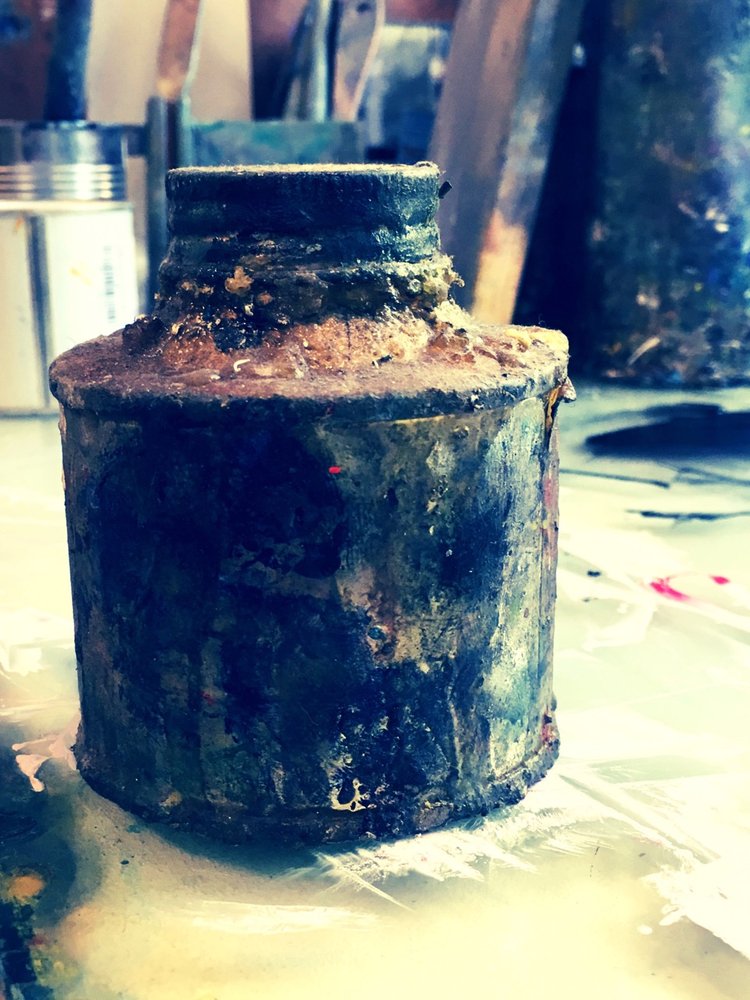Manipulated Polaroid SX-70
Notes on Analogue
By Jonathan S. Hooper
OnAnalogue
The world we inhabit is increasingly characterised by, if not yet completely defined by, digital processes. This digital world [Digital]represents and reproduces reality with discrete pieces of information butted together. Digitalis efficient and its data set, by nature, is readily storable, transmittable and manipulable.
Digitaltechnology enables infinite, unerring multiples and in doing so appears infallible. Digitalabhors imperfection and impermanence and provides the means to eradicate both. Digitalhas no languagefor decay. All of these qualities on face value appear highly desirable, Utopian even.
It might be argued however that it is precisely these qualities that should give pause for thought and lead us to adopt a more cautious approach to how and where digital technology is deployed. The Artsmight be one such discipline in which analogue processes should reassert themselves. In doing so the Artscould play a key role in applying the brakes to Digital'srelentless encroachment.
Painting and the other plastic arts have a vital role to play in resisting the otherwise unchallenged digital hegemony. Where Digitalseeks to do away with uncertainty and error analogue can make a virtue of these qualities. Arguably uncertainty and error are defining characteristics of human experience, characteristics we must learn to embrace and manage rather than seek to eradicate.
The writer and critic John Berger [ref: Bento’s Sketchbook] described drawing as "the process of continually correcting mistakes”. This is a powerful and enabling concept. A concept which can perhaps be further extended towards the conclusion that without a willingness to make mistakesthere can be no progress.
Not only is analogue process a possible bulwark against the relentless march of the Digital, but more fundamentally it can act to reaffirm qualities that are essentially human and humane. Analogue seems to more satisfactorily describe and record how the actualworld works. Digitalis the stuff of the virtual world and this is a world of close approximations masquerading as reality; it is world of hyperreality. The nature of realityremains an unanswered philosophical question and perhaps the preeminence ofDigitalis leading us away from the debate.
Memory defines us as individuals. The fallibility of memory, and its relationship with the processes of time, helps catalyse the imagination and this, in its turn, can be the wellspring of creativity. Digitalnot only compensates for the fallibility of our memories but, in time, it might do away with the need for memory altogether.
Data can be stored in analogue form of course but its various media lack the omnipresence of The Cloud and are subject to decay and deterioration- photographic images fade; tape, film and paper degrade. In this respect the temporality ofAnalogue more closely parallels the essential qualities of human memory.
Digitalis often described as cold or clinical. Digitally reproduced music is said to lack the warmthof vinyl records. Digitalis unarguably the code of the robot age and this association might reasonably create a sense that digital technologies lack human values like empathy, conscience and consciousness. Artis a human construct so any interface that might lack the ability to freely transmit such values must be carefully considered.
Analogue, on the other hand, parallels the innately human characteristics of sub-optimality. Analogue it is not overly concerned about falling short of the ideal and this is perhaps what makes it’s output approachable, non-threatening,warmeven.Digital'sfounding principle is the pursuit of perfection. Perfection is of course unattainable and, in its allusions to perfection, Digitalcreates an unbridgeable gap between itandus;between technology and the people that use it.Where the algorithms of digital production take experimentation out of our hands, or turn experimentation into an illusion, analogue actively encourages us to push the boundaries by showing us the possible riches to be discovered in the unexpected.
Analogue's facility for the unexpected is arguably a major part of its appeal. The scratch on a vinyl record or the chemical mistakein processed film gives each thinga unique and unrepeatable signature. Although analogue does allow repetition it is the subtle differences that become the defining quality of it's repeated forms. Where Digitalobviates the need for close examination- [Digitalpromises perfect clones]- analogue challenges us to spot the difference and from this perhaps helps us get closer to the essence of the thing. It could even be that re-engaging with the analogue world might reassert the value of critical thinking, of discernment, of patience.
For all of its capabilities digital process might actually devalue the thing that it is representing or creating.The unforeseen consequence of Digital'spursuit of consistency, permanence and infallibility could be to make everything common-place. Analogue, on the other hand, dignifies the individual thingby compelling us towards its unique characteristics. This might in turn dignify us as individuals in as much as our relationship with thethingbecomes founded in how we see it rather than how we are told to see it.
The plastic arts are, by definition, determinedly analogue and should remain so; they are hand-made with all that this implies. Despite efforts to the contrary no two objects produced by hand can ever be truly identical. In fact it is probably true to say that there is something innate within the creative impulse or imperative that will not allow us to pursue absolute conformity and consistency. That is not to say that there is no artistic virtue in repetition but that the real value does not lie in the ability to produce perfect facsimiles.
Embarking on any analogue process requires acceptance of the fundamental truth that the production of original work is a collaboration between a practitioner and his/her materials of production. Paintings are paint, selected and manipulated by the painter however the outcome of this manipulation will not just be influenced by the painter's ideas, skills and experience. The outcome must also give attribution to the role of analogue process; it must embrace and endorse the role of uncertainty, chance and mistakes.
JSH 2018

